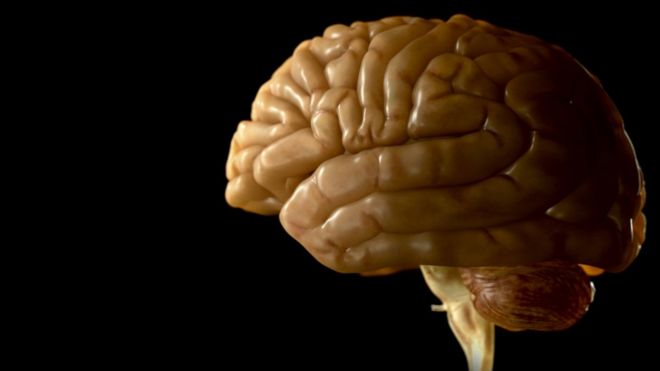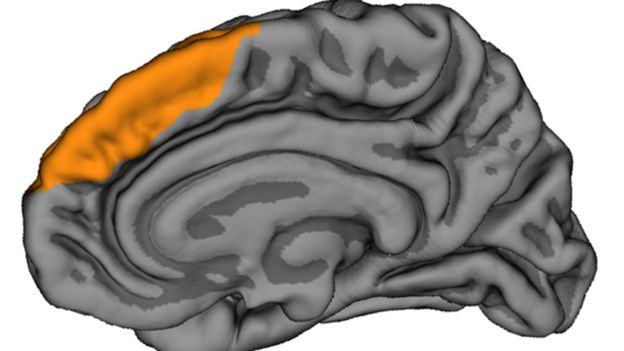
A study of 153 brain scans has linked a particular furrow, near the front of each hemisphere, to hallucinations in schizophrenia.
This fold tends to be shorter in those patients who hallucinate, compared with those who do not.
It is an area of the brain that appears to have a role in distinguishing real perceptions from imagined ones.
Researchers say the findings, published in Nature Communications, might eventually help with early diagnosis.
The brain wrinkle, called the paracingulate sulcus or PCS, varies considerably in shape between individuals. It is one of the final folds to develop, appearing in the brain only just before birth.
"The brain develops throughout life, but aspects such as whether the PCS is going to be a particularly prominent fold - or not -may be apparent in the brain at an early stage," said Jon Simons, a neuroscientist at the University of Cambridge, UK.
"It might be that a reduction in this brain fold gives somebody a predisposition towards developing something like hallucinations later on in life."
If further work shows that the difference can be detected before the onset of symptoms, for example, Dr Simons said it might be possible to offer extra support to people who face that elevated risk.
But he stressed that schizophrenia is a complicated phenomenon. Hallucinations are one of the main symptoms, but some patients are diagnosed on the basis of other irregular thought processes.
 Garrison et al, Nature Communications
Garrison et al, Nature Communications
"We've known for some time that disorders like schizophrenia are not down to a single region of the brain. Changes are seen throughout various different areas.
"To be able to pin such a key symptom to a relatively specific part of the brain is quite unusual."
Monitoring reality
Dr Simons and his colleagues used data from the Australian Schizophrenia Research Bank, including structural MRI scans revealing the detailed physical dimensions of 153 individual brains: 113 people with schizophrenia and 40 healthy controls.
Because this database includes other important information about the subjects, the team was able to choose its samples very carefully.
The schizophrenia patients, for example, were split into those with a history of hallucinations (79 people) and those without (34) - but the two groups were closely matched in other ways.
"We're selecting patients to put into each group such that those two groups are... as directly comparable as possible," Dr Simons told the BBC. Factors such as the individuals' age, sex, medication and even whether they were left- or right-handed were all taken into account.
"So as close as we can get it, the only difference between those two groups is that one group experiences hallucinations and the other one doesn't."
In the brain scans, the team looked for differences in the PCS because they knew from a previous study that the length of this fold showed a correlation with people's "reality monitoring" ability.
And sure enough, this was reflected in the patients suffering hallucinations: on average, they had a PCS that was about 2cm shorter than the patients without hallucinations, and 3cm shorter than the healthy controls.
Turning this measurement around, the team calculated that a 1cm decrease in the length of the furrow corresponded to a 20% increase in the risk of experiencing hallucinations.
 Garrison et al, Nature Communications
Garrison et al, Nature Communications
The study's first author, Jane Garrison, said that although other factors were certainly at play when a brain generates hallucinations, this was an important observation.
"We think that the PCS is involved in brain networks that help us recognise information that has been generated ourselves," she explained. "People with a shorter PCS seem less able to distinguish the origin of such information, and appear more likely to experience it as having been generated externally.
"Hallucinations are very complex phenomena that are a hallmark of mental illness and, in different forms, are also quite common across the general population.
"There is likely to be more than one explanation for why they arise, but this finding seems to help explain why some people experience things that are not actually real."
Stephen Lawrie, a professor of psychiatry at the University of Edinburgh, was not involved with the research but has studied brain structure in relation to schizophrenia and hallucinations.
He said the new findings were thoroughly researched and quite surprising - partly because, although schizophrenia is known to affect frontal parts of the brain like the PCS, hallucinations in particular are often associated with other areas that control perception and language.
"There's quite a strong literature showing that auditory hallucinations are related to dysfunction or structural disruption in language areas of the brain," Prof Lawrie told BBC News.
"I think the value of this is that it probably helps us think slightly more broadly about hallucinations in schizophrenia, in terms of it not just being about language areas of the brain - but involving a more distributed network of regions, and implicating, in particular, cognitive control or higher-order cognitive functioning."
No comments:
Post a Comment